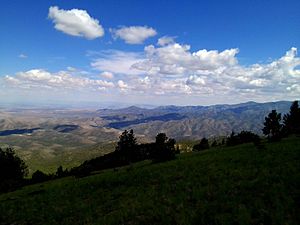Withington Wilderness
| Withington Wilderness | |
|---|---|
|
IUCN category Ib (wilderness area)
|
|

The view of the San Mateo Mountains, southeast of the Withington Wilderness Area.
|
|
| Location | New Mexico, United States |
| Nearest city | Magdalena, NM |
| Coordinates | 33°53′46″N 107°27′32″W / 33.896°N 107.459°WCoordinates: 33°53′46″N 107°27′32″W / 33.896°N 107.459°W |
| Governing body | U.S. Forest Service, Cibola National Forest |
| www |
|
The Withington Wilderness is a 19,000-acre Wilderness area within the Magdalena Ranger District of the Cibola National Forest. The Withington sits within the northern section and on the eastern slope of the San Mateo Mountains in Socorro County, New Mexico. The Withington Wilderness was designated by Congress in 1980. The Withington Wilderness ranges from 6,800 feet to 10,100 feet atop Mount Withington. While the origin of the name for Mount Withington is unclear, it has been suggested that Major George M. Wheeler, leader of the Wheeler Survey, one of the major surveys of the western United States in the late nineteenth century, may have named the peak for William Herbert Withington (1835-1903), a Union Officer in the Civil War. The 8,039-acre White Cap Inventoried Roadless Area is directly adjacent to the Withington Wilderness. The Apache Kid Wilderness, also in the San Mateo Mountains, lies due south of the Withington Wilderness. To the north of the Withington Wilderness and San Mateo Mountains is the world-renowned Very Large Array radio telescope observatory.
The topography in the northern San Mateo Mountains is gentler than in the south, but still contains deep canyons, high ridgelines and generally dry conditions. Winters are cold enough to bring snow, and during July and August, the desert "monsoon" season, rainwater may flood narrow canyons. The vegetation ranges from pine, spruce, and fir at high elevations to pinion and juniper farther down. Near the eastern boundary, at the lowest elevation in the Wilderness, ocotillo stands are found. Habitats in the Withington Wilderness support populations of mountain lion, black bear, elk, mule deer, coyote, turkey and quail. A portion of the Wilderness is critical habitat for the threatened Mexican spotted owl. The greater San Mateo Mountains were identified as a key conservation area by The Nature Conservancy due to their ecological diversity and species richness.
...
Wikipedia

